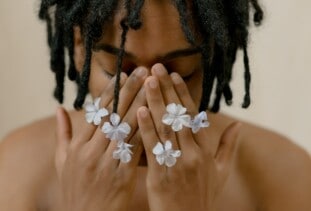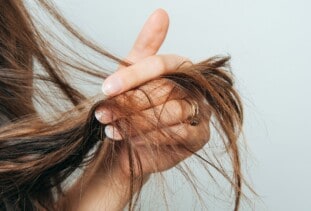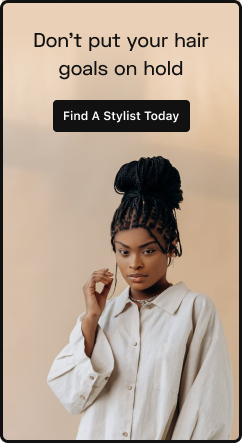Dreadlocks are one of the most versatile natural hairstyles. From traditional Rasta dreadlocks to an ethereal bohemian locs hairstyle, there are many ways to style your dreadlocks. Here we will guide you through the different varieties of the dreadlock hairstyle. As well, we will discuss how to take care of dreadlocks, provide tips to keep your hair growing healthy, explain how to get rid of buildup in dreadlocks, and break down what you can expect with this hairstyle. Let’s cover some of the many ways you can style your locs to switch up your look!
Crinkle Dreadlocks
Crinkle Dreadlocks can be achieved simply by braiding your dreads and leaving the braids in place until they dry. After removing your braids, you will have a crinkled locs hairstyle to show off. You can also achieve a spiral pattern with perm rods or pipe cleaners.
Maintenance
Crinkle dreadlocks require more upkeep than other popular braid styles to retain their look. Based on what method you are using to achieve the crinkly dreadlocks style, you will need to start by setting your hair the night before.
What to expect
If using the perm rod method, give these types of dreads plenty of moisture, roll, and allow room for setting time. Ideally, you will want to let this sit overnight, so it has plenty of time to get nice and dry. Or if you have a hooded dryer, you can use this instead.
You can also expect the pipe cleaner method to be more on the tedious side as it may be a more time-intensive process. Braid-outs or braided dreadlocks will likely be the easiest method to get that desired wavy look. When using the braid out method, simply apply moisture to your hair using a water-based product such as a setting lotion, and braid locs into small sections.
Tips
- Wear a silk or satin bonnet or scarf over your locs to protect them while you sleep.
- If you want a curlier look, curl hair using tube cleaners.
- Dampen your hair with a little bit of water to help the formation/molding of the crimps.
Bohemian Dreadlocks
Bohemian dreadlocks are the combination of faux locs wrapped with a mix of different textured braiding hair to give it a distressed, messy look. Think Lisa Bonet.
Maintenance
Compared to other popular Black braided hairstyles, bohemian dreadlocks are a low-maintenance and very long-lasting protective hairstyle. Since these types of hair dreadlocks are meant to look worn and frizzy, they age very well. If you sleep with a bonnet or silk scarf at night and adequately maintain the locs, bohemian locs can last two to three months.
What to expect
Bohemian locks may have waves or curls hanging out of each loc. They also may be random in length. Towards the front of your locs, there is a tendency for one of two Bohemian locs to be much shorter in length, which will add an accent to the entire style.
Tips
- Bohemian locs are meant to look unkempt, so they look better as time goes by and the longer they are worn.
- Clean your scalp using dry shampoo and a cotton ball or piece of cloth.
- Use an anti-itch scalp oil to soothe any irritation or tension in your scalp.
Rasta Dreadlocks
Rasta dreadlocks are one of the more traditional loc styles. They are rope-like strands of hair formed by locking or braiding hair. The style is visually similar to braids, but whereas braids can be installed and “finished” immediately, most dreadlocks hairstyles properly require a period of maturation.
Various methods are used to prepare and maintain this style, including salon treatments, but merely not brushing nor conditioning one’s hair is usually sufficient to form the Rasta look.
Maintenance
To help maintain the health of Rasta dreadlocks, only use the best hair products for natural hair, created specifically for dreadlocks. Because dreadlocks are dense mats of hair, shampoo residue does not rinse away. Use a low-lather shampoo that rinses cleanly.
In addition, use natural oils like olive, jojoba, or rosemary to condition the dreadlocks and prevent breakage. Wash your dreads, but do so infrequently. It is a misconception that you should not wash dreadlocks.
Unwashed dreadlocks can cause frizz, odor, and break due to internal rotting. In terms of how often to wash natural hair, when first creating dreadlocks, you should wash your hair one to two weeks, but maintain a once-a-week regimen to treat your hair with lightweight oil or replenishing spray.
Establishing a waxing routine will also help maintain the health of locs. Dreadlocks maintain their shape through the careful application of beeswax. The wax holding dreadlocks together wash away over time. Dreadlocks should be re-waxed frequently to maintain a smooth look and reduce frizz. Mature dreadlocks only need to be waxed every few weeks.
Lastly, you can palm roll the dreadlocks to help maintain your style. Continue to palm roll each dreadlock in a clockwise direction after every wash. This will keep the loc tight and incorporate any new hair at the root as it grows out.
What to expect
The expectations for rasta dreadlocks will differ based on your hair type and texture. Generally, it could take anywhere from ten months to two years to get to the last stage of locs, known as the rooted stage.
Tips
- Make an appointment with a loctician – a stylist that specializes in the making and care of dreadlocks.
- Only use products created for dreadlocks to maintain proper care.
Twisted Dreadlocks
This style is achieved by taking two individual dreads and twisting them in a two-strand twist technique. This style is fairly common, especially for those starting with longer hair.
Maintenance
Starting with the two-strand twist method, the twists hold the hair, and the roots begin their locking process. One of the best things about this method is that the technique is easy to maintain.
What to expect
Twisted locs resemble a traditional twisted hairstyle while you wait for your locs to mature. They are easy to start and don’t require any professional installation. Prepare for your twists to unravel toward the beginning stages.
You can expect twisted dreads to turn out thick when they begin to form. It could take anywhere from six to 12 months to two years for your twists to begin appearing like traditional locs. Keep in mind, everyone’s hair is different, so try not to compare your hair maturation to others.
Tips
- Avoid over-moisturizing your hair during the beginning stages to prevent unraveling.
- If your twisted dreads do unravel, you can make a knot and tie them together.
Freeform Dreadlocks
The freeform method allows dreadlocks to form organically. This style was introduced to pop culture by musical icon Bob Marley. All freeform locs require is letting them grow with the assistance of little to no hair products and little to no manipulation.
Maintenance
Freeform dreads, also known as freedom or freestyle dreads, are a great low-maintenance option that can easily be taken care of at home. They allow people to embrace their natural hair texture without having to deal with the application of heavy products or common styling tools like combs and brushes. But, how do you get dreadlocks following the freeform method?
Freeform dreadlocks should be left to do their own thing, especially when they’re just starting out. This locking method actually requires that you do nothing at all. By doing nothing, your hair will start to form buds (baby locks). Leave them as they are or carefully separate bigger buds to form what will later become thinner individual locks.
While freeform dreads don’t need any special attention to get started, they still need to be maintained. If they aren’t maintained, you can run the risk of having them weaken, break off, and will be unhealthy. You still need to wash your hair, oil your scalp, and protect your locs with a silk or satin scarf at night to keep them smooth and lint-free.
What to expect
Freeform locs can help you save money since you won’t need many products to style your hair. You also won’t need to worry about costly trips to the salon to get them retwisted, since they don’t require re-twisting like other locs styles. Lastly, freeform dreadlocks can be grown into any shape to form intricate up-dos, Bantu knots, or loose locs.
Tips
- Tighter textured hair is best for freeform style locks.
- Wash your locks every one to two weeks and let them dry.
- Use natural oils and creams to groom your hair and moisturize your scalp.
- Massage your scalp to stimulate circulation and keep it healthy.
- Keep heavy pomades and waxes out of your hair to avoid buildup.
- Try an apple cider vinegar rinse to remove lint and buildup from your locs.
Different types of dreadlocks are a great way to switch things up and create a different look. No matter how you style your hair, dreadlocks are a beautiful and great protective style. Utilizing different maintenance routines, being aware of what to expect when trying to achieve different looks and using a range of techniques will help your locs to be as healthy as possible. And if you are in need of inspiration or a major loc refresh, make sure to rely on the help of qualified beauty professionals.
Across the range of styles, it’s always important to make sure you hydrate your hair, dry your locs properly, and don’t retwist them too often. Having a great hair care routine is always the first step to healthy hair, no matter what style you want to try! Whether you are looking for the best dreadlocks Houston stylists offer or the best dreadlocks Atlanta salons recommend, we have your covered at StyleSeat.
Sources:
https://melbournedreadlocks.com.au/how-to-moisturise-dreadlocks/
https://www.refinery29.com/en-us/2015/04/86174/history-of-dreadlocks
https://www.ebony.com/style/history-dreadlocks/






